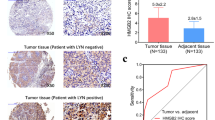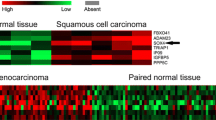Abstract
High-mobility group A1 (HMGA1) has been suggested to play a significant role in tumor progression, but little is known about the accurate significance of HMGA1 in non-small cell lung cancer (NSCLC) patients. The aim of this study was to identify the role of HMGA1 in NSCLC. The expression status of HMGA1 was observed initially in NSCLC by Gene Expression Omnibus (GEO). The expression of HMGA1 messenger RNA (mRNA) and protein was examined in NSCLC and adjacent normal lung tissues through real-time PCR and immunohistochemistry. Meanwhile, the relationship of HMGA1 expression levels with clinical features and prognosis of NSCLC patients was analyzed. In our results, HMGA1 was overexpressed in NSCLC tissues compared with adjacent normal lung tissues in microarray data (GSE19804). HMGA1 mRNA and protein expressions were markedly higher in NSCLC tissues than in normal lung tissues (P < 0.001 and P = 0.010, respectively). Using immunohistochemistry, high levels of HMGA1 protein were positively correlated with the status of clinical stage (I–II vs. III–IV, P < 0.001), T classification (T1–T vs. T3–T4, P = 0.003), N classification (N0N1 vs. N2–N3, P < 0.001), M classification (M0 vs. M1, P = 0.002), and differentiated degree (high or middle vs. low or undifferentiated, P = 0.003) in NSCLC. Patients with higher HMGA1 expression had a significantly shorter overall survival time than did patients with low HMGA1 expression. Multivariate analysis indicated that the level of HMGA1 expression was an independent prognostic factor (P < 0.001) for the survival of patients with NSCLC. In conclusion, HMGA1 plays an important role on NSCLC progression and prognosis and may act as a convictive biomarker for prognostic prediction.




Similar content being viewed by others
References
Siegel R, Ma J, Zou Z, Jemal A. Cancer statistics, 2014. CA: Cancer J Clin. 2014;64:9–29.
Rosell R, Karachaliou N. Lung cancer: maintenance therapy and precision medicine in NSCLC. Nat Rev Clin Oncol. 2013;10:549–50.
Spira A, Ettinger DS. Multidisciplinary management of lung cancer. N Engl J Med. 2004;350:379–92.
Johnson KR, Lehn DA, Reeves R. Alternative processing of mRNAs encoding mammalian chromosomal high-mobility-group proteins HMG-i and HMG-y. Mol Cell Biol. 1989;9:2114–23.
Reeves R, Nissen MS. The a.T-DNA-binding domain of mammalian high mobility group i chromosomal proteins. A novel peptide motif for recognizing DNA structure. J Biol Chem. 1990;265:8573–82.
Shah SN, Resar LM. High mobility group A1 and cancer: potential biomarker and therapeutic target. Histol Histopathol. 2012;27:567–79.
Xing J, Cao G, Fu C: HMGA1 interacts with beta-catenin to positively regulate wnt/beta-catenin signaling in colorectal cancer cells. Pathology Oncology Research: POR 2014.
Tesfaye A, Di Cello F, Hillion J, Ronnett BM, Elbahloul O, Ashfaq R, et al. The high-mobility group A1 gene upregulates cyclooxygenase 2 expression in uterine tumorigenesis. Cancer Res. 2007;67:3998–4004.
Di Cello F, Shin J, Harbom K, Brayton C. Knockdown of HMGA1 inhibits human breast cancer cell growth and metastasis in immunodeficient mice. Biochem Biophys Res Commun. 2013;434:70–4.
Xi Y, Li YS, Tang HB. High mobility group A1 protein acts as a new target of notch1 signaling and regulates cell proliferation in T leukemia cells. Mol Cell Biochem. 2013;374:173–80.
Larsson L, Jawert F, Magnusson B, Hasseus B, Kjeller G. Expression of high mobility group a proteins in oral leukoplakia. Anticancer Res. 2013;33:4261–6.
Chiappetta G, Manfioletti G, Pentimalli F, Abe N, Di Bonito M, Vento MT, et al. High mobility group HMGi(y) protein expression in human colorectal hyperplastic and neoplastic diseases. Int J Cancer J Int Cancer. 2001;91:147–51.
Chiappetta G, Botti G, Monaco M, Pasquinelli R, Pentimalli F, Di Bonito M, et al. HMGA1 protein overexpression in human breast carcinomas: correlation with ErbB2 expression. Clin Cancer Res: Off J Am Assoc Cancer Res. 2004;10:7637–44.
Tamimi Y, van der Poel HG, Denyn MM, Umbas R, Karthaus HF, Debruyne FM, et al. Increased expression of high mobility group protein i(y) in high grade prostatic cancer determined by in situ hybridization. Cancer Res. 1993;53:5512–6.
Abe N, Watanabe T, Masaki T, Mori T, Sugiyama M, Uchimura H, et al. Pancreatic duct cell carcinomas express high levels of high mobility group i(y) proteins. Cancer Res. 2000;60:3117–22.
Masciullo V, Baldassarre G, Pentimalli F, Berlingieri MT, Boccia A, Chiappetta G, et al. HMGA1 protein over-expression is a frequent feature of epithelial ovarian carcinomas. Carcinogenesis. 2003;24:1191–8.
Takahashi Y, Sawada G, Sato T, Kurashige J, Mima K, Matsumura T, et al. Microarray analysis reveals that high mobility group A1 is involved in colorectal cancer metastasis. Oncol Rep. 2013;30:1488–96.
Chang ZG, Yang LY, Wang W, Peng JX, Huang GW, Tao YM, et al. Determination of high mobility group A1 (HMGA1) expression in hepatocellular carcinoma: a potential prognostic marker. Dig Dis Sci. 2005;50:1764–70.
Wang EL, Qian ZR, Rahman MM, Yoshimoto K, Yamada S, Kudo E, et al. Increased expression of HMGA1 correlates with tumour invasiveness and proliferation in human pituitary adenomas. Histopathology. 2010;56:501–9.
Fedele M, Palmieri D, Fusco A. HMGA2: a pituitary tumour subtype-specific oncogene? Mol Cell Endocrinol. 2010;326:19–24.
Chiappetta G, Avantaggiato V, Visconti R, Fedele M, Battista S, Trapasso F, et al. High level expression of the HMGi(y) gene during embryonic development. Oncogene. 1996;13:2439–46.
Ben-Porath I, Thomson MW, Carey VJ, Ge R, Bell GW, Regev A, et al. An embryonic stem cell-like gene expression signature in poorly differentiated aggressive human tumors. Nat Genet. 2008;40:499–507.
Abe N, Watanabe T, Izumisato Y, Suzuki Y, Masaki T, Mori T, et al. High mobility group A1 is expressed in metastatic adenocarcinoma to the liver and intrahepatic cholangiocarcinoma, but not in hepatocellular carcinoma: its potential use in the diagnosis of liver neoplasms. J Gastroenterol. 2003;38:1144–9.
Balcerczak M, Pasz-Walczak G, Balcerczak E, Wojtylak M, Kordek R, Mirowski M. HMGi(y) gene expression in colorectal cancer: comparison with some histological typing, grading, and clinical staging. Pathol Res Pract. 2003;199:641–6.
Liau SS, Jazag A, Whang EE. HMGA1 is a determinant of cellular invasiveness and in vivo metastatic potential in pancreatic adenocarcinoma. Cancer Res. 2006;66:11613–22.
Reeves R, Edberg DD, Li Y. Architectural transcription factor HMGi(y) promotes tumor progression and mesenchymal transition of human epithelial cells. Mol Cell Biol. 2001;21:575–94.
Shah SN, Kerr C, Cope L, Zambidis E, Liu C, Hillion J, et al. HMGA1 reprograms somatic cells into pluripotent stem cells by inducing stem cell transcriptional networks. PLoS One. 2012;7:e48533.
Pegoraro S, Ros G, Piazza S, Sommaggio R, Ciani Y, Rosato A, et al. HMGA1 promotes metastatic processes in basal-like breast cancer regulating emt and stemness. Oncotarget. 2013;4:1293–308.
Wang DS, Pan CC, Lai HC, Huang JM. Expression of HMGA1 and ezrin in laryngeal squamous cell carcinoma. Acta Oto-Laryngol. 2013;133:626–32.
Takaha N, Sowa Y, Takeuchi I, Hongo F, Kawauchi A, Miki T. Expression and role of HMGA1 in renal cell carcinoma. J Urol. 2012;187:2215–22.
Sarhadi VK, Wikman H, Salmenkivi K, Kuosma E, Sioris T, Salo J, et al. Increased expression of high mobility group a proteins in lung cancer. J Pathol. 2006;209:206–12.
van der Zee JA, ten Hagen TL, Hop WC, van Dekken H, Dicheva BM, Seynhaeve AL, et al. Differential expression and prognostic value of HMGA1 in pancreatic head and periampullary cancer. Eur J Cancer (Oxford, England : 1990). 2010;46:3393–9.
Hristov AC, Cope L, Di Cello F, Reyes MD, Singh M, Hillion JA, et al. HMGA1 correlates with advanced tumor grade and decreased survival in pancreatic ductal adenocarcinoma. Mod Pathol: Off J U S Can Acad Pathol Inc. 2010;23:98–104.
Liau SS, Whang E. High mobility group a: a novel biomarker and therapeutic target in pancreatic adenocarcinoma. Surg: J Royal Coll Surg Edinb Irel. 2009;7:297–306.
Qu Y, Wang Y, Ma J, Zhang Y, Meng N, Li H, et al. Overexpression of high mobility group A1 protein in human uveal melanomas: implication for prognosis. PLoS One. 2013;8:e68724.
Acknowledgements
This work was supported by the funding from the Rubber Manufacturing occupational hazard protection guidelines, the Ministry of Health project (2009_03-05), the Technology Development Foundation of Pudong District (PKJ2013-Y67), and the Experimental Animal Special Purpose Foundation of Science and Technology Commission of Shanghai Municipality (13140902901).
Conflicts of interest
None
Author information
Authors and Affiliations
Corresponding authors
Rights and permissions
About this article
Cite this article
Zhang, Z., Wang, Q., Chen, F. et al. Elevated expression of HMGA1 correlates with the malignant status and prognosis of non-small cell lung cancer. Tumor Biol. 36, 1213–1219 (2015). https://doi.org/10.1007/s13277-014-2749-4
Received:
Accepted:
Published:
Issue Date:
DOI: https://doi.org/10.1007/s13277-014-2749-4




